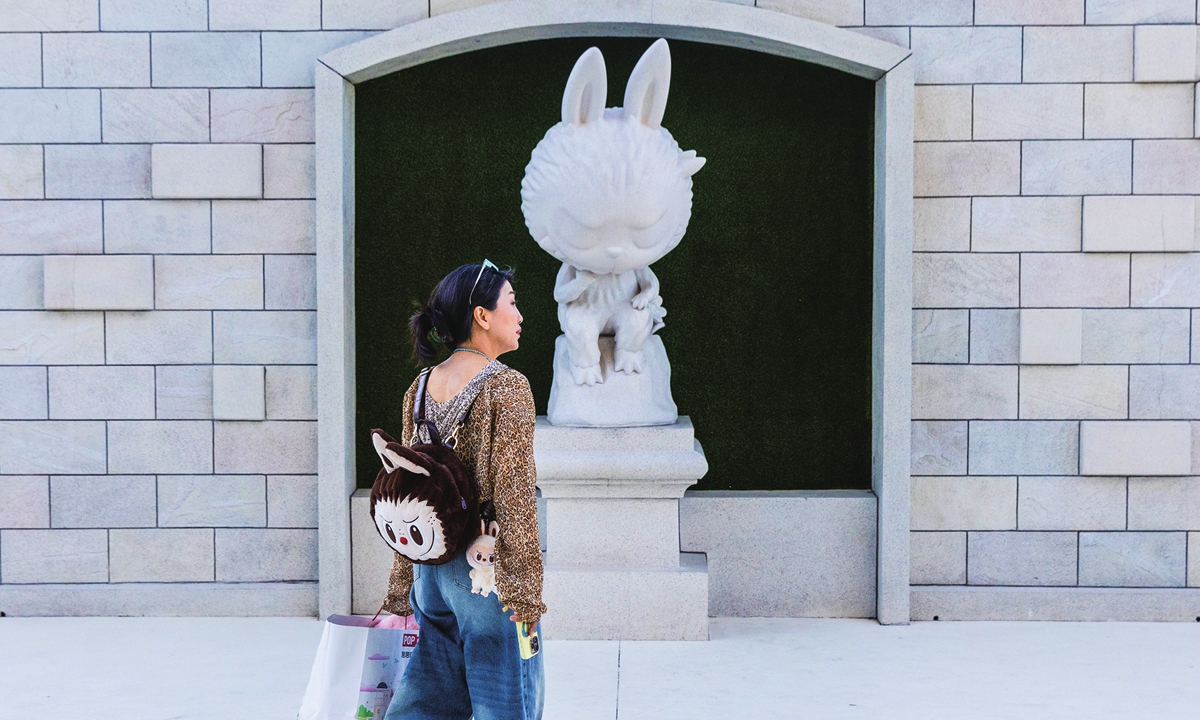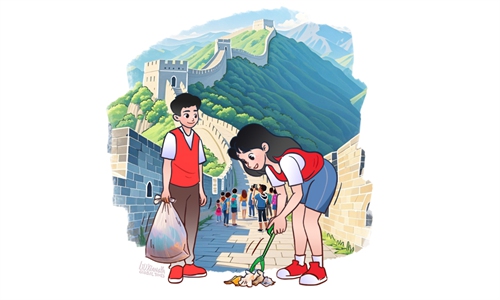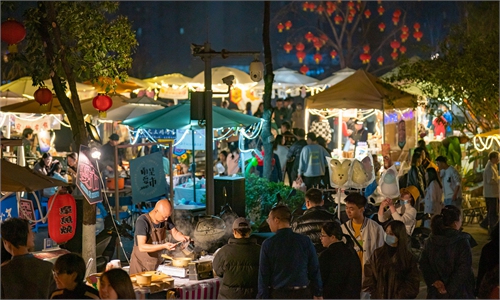ARTS / CULTURE & LEISURE
The rising popularity of quirky toys among adults
A new aesthetic wave

A visitor passes by a Labubu statue during an organized tour on June 3, 2025 in Popland, a theme park opened by Chinese toy company PopMart in Beijing. Photo: VCG
During this year's International Children's Day, a consumer and industrial development research institute conducted a survey of 1,000 toy enthusiasts in China, including not only GenZers (9.6 percent) but also older millennials, with 1980s-born respondents making up 30.4 percent and 1990s-born nearly half at 48.6 percent. The survey went deep to explore what groups of people celebrate the holiday, and what kinds of toys they are buying, according to a report from the China Fortune Media Group.
The survey found that for this crowd, designer toys, or chaowan, blind boxes are one of the most favored items, with more than 60 percent having purchased them.
Although cute and comforting styles of trendy toys dominate the mainstream, a more quirky style is rapidly gaining popularity, capturing nearly 30 percent of the votes.
"These quirky figures are loved precisely because they defy the idea of perfection," Li Yang, a Beijing-based market analyst, told the Global Times on Wednesday. "They've become a new medium for young people to express themselves."
Toys with attitude
Designer toys are becoming a growing part of adult life in China, and the enthusiasm behind them is far from fleeting. According to Shanghai Morning Post, over 60 percent of adults have entered the world of designer toys, with a growing number of "hardcore collectors" making it part of their daily routines. Some count more than 20 pieces in their personal collections.
"For these enthusiasts, buying a toy is more than just a transaction, it's a way to assert their aesthetic tastes," Li noted.
"This Labubu figure looks exactly like me," Sun Sili, an employee at a state-owned enterprise in Beijing, told the Global Times on Wednesday. Her office desk features a Jellycat plush octopus, a LEGO race car, and rows of PopMart collectibles, each one reflecting a different emotional state.
Today, these toys are no longer content with sitting quietly on desktops or bedsides. They've become part of the city dwellers' daily rhythm, appearing more visibly in public. Increasingly, adult fans hang them from backpacks, keychains, and even phone cases.
According to China Fortune Media Group, the survey shows that more than 68 percent of adults regularly carry plush keychain accessories, and over 35 percent have come to see them as a daily essential.
This wave of "bag charm culture" brings more than just visual cuteness, it offers a sense of daily companionship. Whether on the morning commute, at social gatherings, or in travel photos, these plush charms are making more and more frequent appearances.
"My designer toy keychain has already been with me to six different cities, even when I'm traveling for work, I never leave it behind," Sun said.
"When I'm exhausted, just giving its soft little ears a gentle squeeze brings this fleeting sense of calm, a rare moment of 'instant healing,'" she noted. "There's something deeply comforting about the physical presence: something you can touch, something you can see."
Plush keychains are more than just cute accessories, they're statements of personal attitude. A lot of users see these plush charms as symbols of self-expression, while many incorporate them into their overall outfits, from color coordination to style matching, these toys have long outgrown the category of mere "playthings."
From offline to online, "bag charm posts" are becoming a new formula for engagement, turning these soft, fuzzy objects into a form of social currency. Data from CBNData shows that sales of plush keychain products have more than doubled year-on-year, with the trend expanding from offline habits to online culture, evolving from niche personal preference to a full-fledged cultural phenomenon.
From office desks to backpacks, from quiet nights to curated social media posts, designer toys are quietly weaving themselves into the emotional lives of adults, a silent but present companion in modern life.

Nezha designer toys Photo: VCG
Quiet shift
As designer toys increasingly permeate the emotional world of adults, a quiet shift in aesthetic taste is also underway. The once-dominant trend of "soft and soothing" cuteness is being challenged by a rising wave of quirky designs.
Labubu and the "Demonic Nezha" version of the mythological character have become standout icons of this trend. On various trending toy charts, both have climbed to the top, not so much because of conventional good looks, but because they strike a deeper chord with the modern psyche.
"When we were kids, we liked things that were simply beautiful. Now, we need characters that can roll their eyes for us," Sun said. "Nezha represents the spirit of 'my fate is mine, not the heavens,' which pretty much sums up the mindset of working millennials."
"This aesthetic shift, at its core, reflects a growing need among adults for self-expression," Huang Yixiao, an education specialist and English teacher based in Shanghai, told the Global Times on Thursday. "Many people see these toy characters as emotional outlets."
On social media, users often discuss how "weird-cute characters feel more human," with some jokingly saying, "these toys are the only ones who truly understand me."
"The fatigue with perfect personas is a collective feeling of our time," Huang noted. "As standardized beauty ideals and social roles become increasingly similar, people are more inclined to embrace imperfection, even thorniness, as a form of individuality, even if it's projected onto a palm-sized figure."
According to Huang, such quiet reinvention of toy aesthetics reflects a more complex and emotionally honest adult inner world. These toys are no longer just toys, they may be helping a generation redefine themselves through a new, unconventional kind of cuteness.



